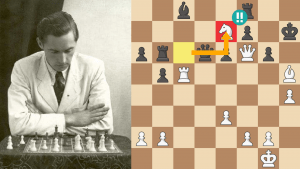
Dreams: The Secret Formula For Chess Success, Part 4
What in the world is a chess dream? And how can such a thing help your game?
This series is all about dreams (okay, it’s also about imbalances and patterns), and it’s presented in a question-and-answer format. Some of the positions will be hard to deconstruct, some will be very basic, but all of them should prove instructive once you do your best to solve the puzzles and then carefully read the prose in the answers.
Chess dreams: No, we’re not talking about a chess dream where hordes of models –- in awe of your chess skills -– flock to you. The chess dream I’m talking about is:
A) You break down the nuts and bolts of the position (imbalances, dynamics, tactics, pawn structures, etc.) as best you can (more concepts than moves!).
B) Then you imagine (Dream!) the ideal position based on your earlier breakdown. No move-by-move, “I go there and he goes there” analysis!
C) That’s enough, but if you wish to go a bit deeper down that rabbit hole, then look for a sequence of moves that actually makes (or at least aims at making) your dream come true.
Here’s another way of looking at chess dreams: reverse engineering!

In a way, high-level chess demands a certain skill in reverse engineering. You first note the weaknesses in the enemy camp, or (based on familiar patterns) you see (dream) the kind of position that you would like to have, and then you work backward to find a way to create it.
Keep in mind that a chess dream can’t be pie in the sky! It has to conform to the position’s needs. That means your dream might only create equality, or something better or worse (depends on the state of your position when you started your dream). All in all though, the dream will lead you to the right path, and give you all that the position can give.

PUZZLES
Puzzle One:
Puzzle Two:
Black is pouring it on White’s position and things are extremely complicated. Can a dream help you in a complicated, rather tactical position? Yes! In this case you need to find one positional idea (it’s screaming to be noticed!), find a way to make it a reality, and then make sure you make it the overriding theme of the game.
ANSWERS
Puzzle One:
Black’s dreams revolve around White’s d- and e-pawns. Can Black win one of them? If not, can he create a situation where he has lasting pressure against one or both of them? The first thing Black has to get out of his system is the attempt to win White’s e5-pawn: 15...Bxf3 16.Bxf3 dxe5 17.d5 Nc5 18.Qc2 (18.Qc4 leads to the same moves) when Black has to settle for 18...Nd4 19.Rxd4 exd4 20.Qxc5, which is very much in White’s favor.
So, since there’s no way for Black to take the game by storm, you need to (ideally) create a structure that gives you lasting chances against some enemy point. Since both Black knights are hitting d4, that’s the target. Once you come to that realization, you need to do various “little” things like stripping away White’s defenders of d4, freezing the d4-pawn so it can move forward, and continuing to pile on pressure against your designated target.
Puzzle Two:
The one positional plus that White would dearly love to nurture is the power of his b2-bishop, which is ruling the a1-h8 diagonal. However, since he’s faced with some serious problems (how can White defend his d2-knight?), isn’t fawning over a nice diagonal a bit out of line?
It turns out that White has a nice combination that turns the game around. But the combination doesn’t lead to a win of material or an attack, it leads to positional superiority. Thus, when you do see a combination that simply changes the landscape of the game but doesn’t lead to the violence or material gain that most think a combination does, you have to decide if the resulting position is what you want.
And the only way to know that is if you have the positional perks that a quiet position needs. In other words, after the combination is over, calculation will take a back seat to strategic understanding. But you need to recognize that strategic path before you play the combination!
RELATED STUDY MATERIAL
- Read IM Silman's previous article: Dreams: The Secret Formula For Chess Success, Part 3.
- Watch IM Keaton Kiewra's video: Fischer Beats Spassky's Best Opening!
- Play as Fischer in the Chess Mentor.
- Solve some puzzles in the Tactics Trainer.
- Looking for articles with deeper analysis? Try our magazine: The Master's Bulletin.






